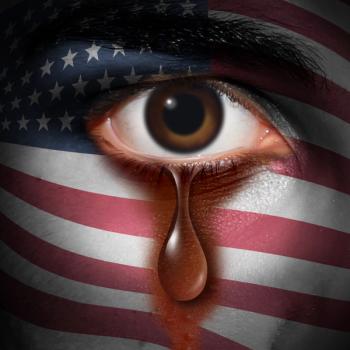
Face Time, Real Time
The face of the woman sitting across from me begins to quiver, and my job as a psychiatrist is to keep my mouth shut. I knew when she came in and said her beloved Scottie of 15 years had died how big a loss that was.
The face of the woman sitting across from me begins to quiver, and my job as a psychiatrist is to keep my mouth shut. I knew when she came in and said her beloved Scottie of 15 years had died how big a loss that was. Now her cheeks tremble and when she says, “Buster walked into the kitchen and tumbled over sideways,” the tears come out, she sobs, and I am stunned, too. My eyes water up a bit. Then I pull back to clinical mode. Her glance picks it up--both my emotion, then detachment--which is fine, the way it ought to be. All this takes place in less than a minute---real time, brain time. Then back to talking.
I have a soft spot for Scotties, and for this woman I have known for more than 15 years. But it isn't only that. We are all wired for empathy, the emotional spark, the genie in the bottle, and that's what I mean when I talk of a real connection with others. Face time, real time.
Digital technology is a valuable tool, of course, but if it dazzles us with speed and control there is the risk it may make us forget the old way of connecting. People can be trained, grooved, to imitate a computer and attempt to do broadband multitasking all day, every day. The old social connection by faces and brains could be lost.
What you're reading here is Times New Roman, 12 point font. Do you believe that I am real, or is this Times New Roman, 12 point, simply a mask. . . something I put on to conceal myself? I am suggesting here that the earlier technology of print is not especially real to most people. I do not expect that you take it too seriously- not until you read further and consider the consequences of what I am saying. You could easily disregard my comments. If we were speaking together face to face in the same room, I might engage you more, and we’d feel more connected. You would know 10 times more about me (that has been quantified). We might trust each other and reach some understanding
But we are, of course, in different rooms, so this digital means of communicating is very useful.
These observations are the crux of the benefits and the risks of e-mail, Facebook, online business, and Electronic Health Records (EHRs). The new health care law has expanded the market by millions of patients. Private insurance companies will have a bonanza, the honor, and the challenge of treating them. For years doctors have been scheduled into smaller segments of time per patient. They don’t have the time or energy to talk with each other (see the statistics on family doctor burn-out). The insurance companies hope that EHRs will be the salvation of health care reform. The stimulus package has promised $27 billion to hospitals and clinics that use EHRs. Doctors will flash brilliant notes to each other and all will be instantly available online.
The problem is that software companies and attorneys have designed these EHRs to be mainly symptoms, diagnoses, and lab results. They use the DSM-IV and the official Procedural Codes (CPTs). For the woman above, for example, they might have these boxes to fill in: "45 years old, depressed, vegetative symptoms, non-suicidal, borderline sugar, loss of pet, DSM 296.23" No room is left for the person's past, the story, drama, or any emotion. The priorities are to code for reimbursement and to protect all parties from liability. The patient looks like a skeleton.
You can say that such notes are simply the outline, that I and other doctors will know the whole story. Maybe so, or will we be trained to forget it? The EHR may work better when devoted to more quantitative diseases, such as diabetes or renal disease, but it is especially constricting in psychiatry. I have recently seen EHR reports about patients who were in a psychiatric hospital for 3 weeks that showed lots of lab data, no narrative, and little suggestion of what took place for those 3 weeks. They do name the next responsible professional, again to protect from liability. The danger of the EHR is that doctors and others may mistake this stripped down abstraction for an authentic picture of the individual, and real connections will be lost. A patient at a point of crisis will notice and hate the impersonal treatment-especially if the doctor is typing during the entire visit---though he may not be able to put it into words.
Of course I believe that computers, e-mail, google searches, and EHRs are useful (as well as the YouTube shortlist). But there is much in life that cannot be codified.
Running into the grocery store the other day, I saw a neighbor, David, rolling out his kid in a stroller. David was tan and striding with pride. I said he looked fit, he grinned and said I did too, and given that encouragement I bragged of sailing on a gusty day, flipping 3 times---and he said he chaired the nationals for the Laser regatta and he came in second! This exhilarating encounter took 2 minutes and could not have been transmitted online. Coincidence, surprise, eye contact, and tone are essential for any real connection.
The other side is true too. The artsy lady who makes jewelry was packing her iPad at Starbucks when I sat down. “Is that thing any good?” I asked. “I’m no techie nerd,” she said. “I like color and depth. I won’t read or write 50 e-mails in my life. I want voice, inflection, tone, the whole person. This thing has got great color and sound, though, and I’ve got 60 gigs of pictures. This afternoon I’m going to get a keyboard.”
I take it all in, her smile and enthusiasm, and I have to admit I’m thinking of buying one.
Newsletter
Receive trusted psychiatric news, expert analysis, and clinical insights — subscribe today to support your practice and your patients.

















